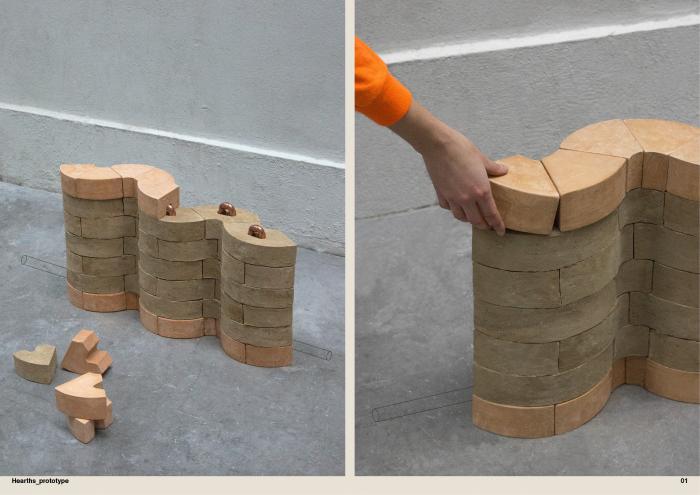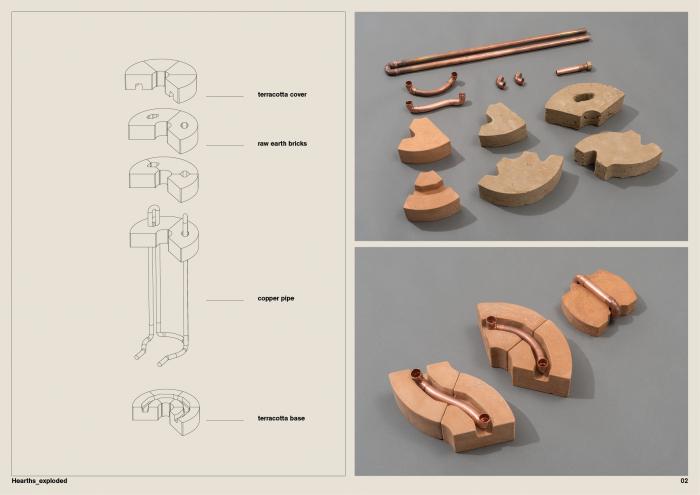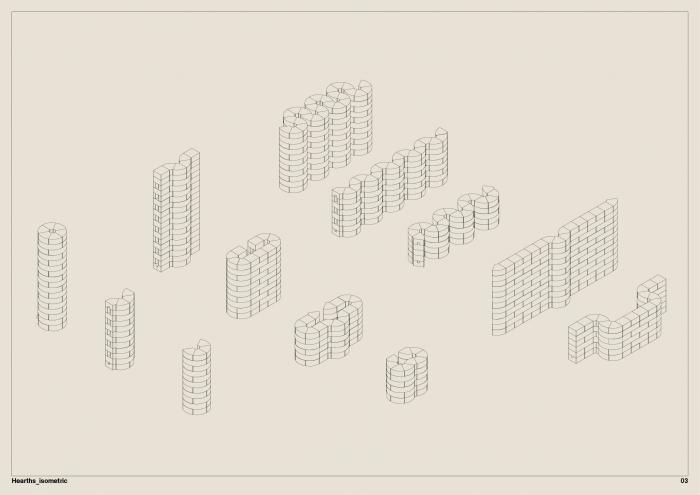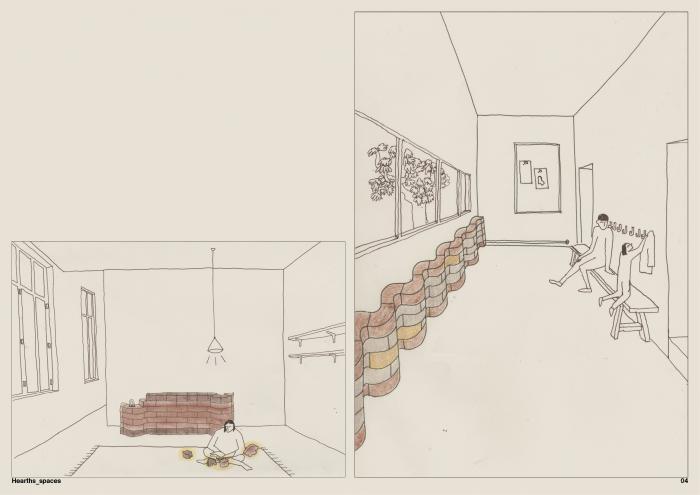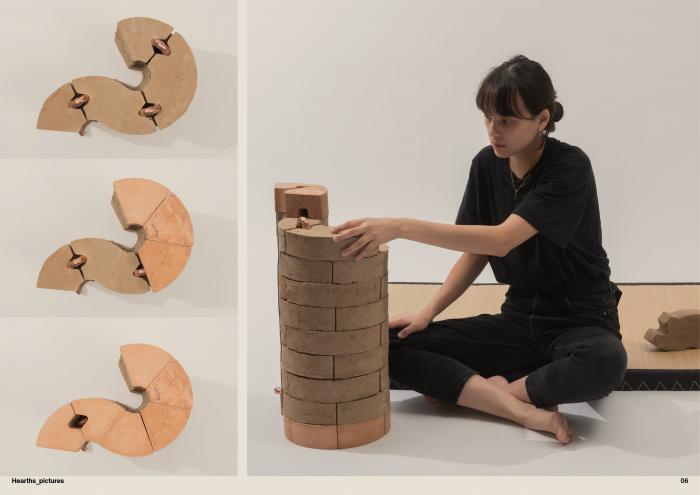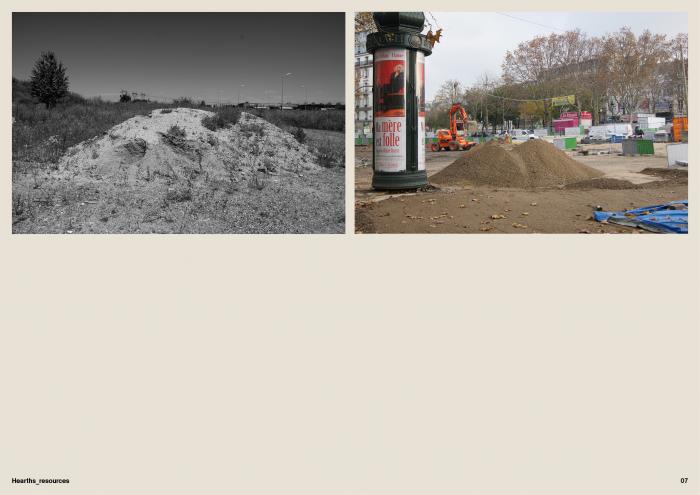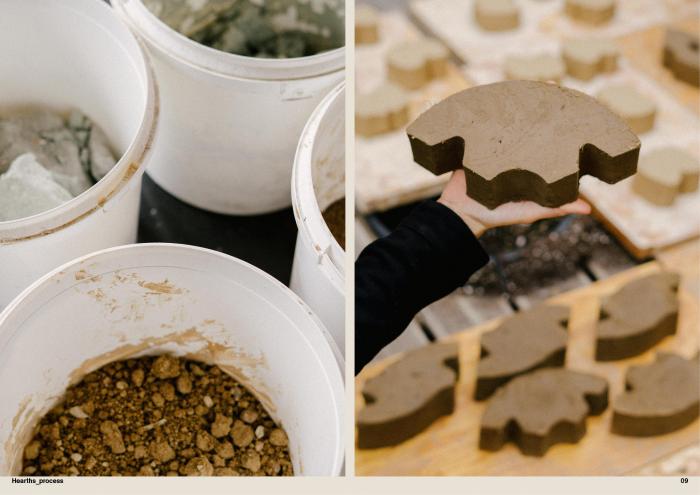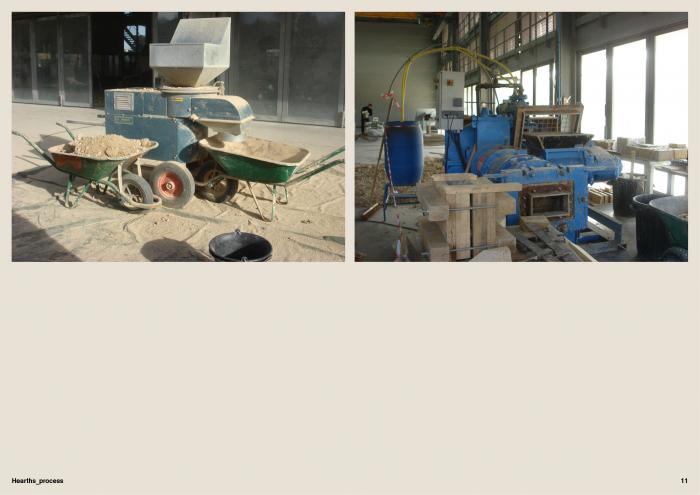I. SUMMARY INFORMATION
Project
268981
Status
Submitted
Award category
Techniques, materials and processes for construction and design
You want to submit
NEW EUROPEAN BAUHAUS RISING STARS : concepts or ideas submitted by young talents (aged 30 or less)
Project title
Hearths
Full concept/idea title
Domestic and collective heat exchanger based on raw earth materials
Description
In the Paris region, more than twenty million tons of soil are excavated per year for land development projects. Considered as an inert waste, raw earth has in fact natural qualities of thermal inertia and humidity regulation. Hearths takes advantage of these valuable properties to offer a domestic and collective heat exchanger system - radiator and conditioner, passive and low-tech, produced locally with no negative impact, as the bricks are made in a fully reversible material.
Where is your concept/idea being developed or intended to be implemented in the EU?
France
Paris
48 rue Saint-Sabin
Paris
75011
II. DESCRIPTION OF THE PROJECT
Please provide a summary of your concept/ idea
Hearths is a domestic and flexible appliance that challenges the standards of thermal comfort in our modern societies. The project illustrates how our existing urban housing can use energy intelligently by integrative design in a context of climate change.
Hearths is inspired by an ancestral technique of earthen constructions. Adobe bricks, made of raw earth and natural fibers, are molded manually or mechanically and naturally dried. This primal material in vernacular building cultures has proven its efficiency to provide comfort in hot, humid but also cold weathers.The aim is to use the natural properties of raw earth to provide thermal comfort in urban areas for all seasons, especially adapted to sudden upward or downward shifts in temperatures. The high thermal inertia, capacity of hygrometric regulation and thermal phase shift make raw earth the most suitable material for a domestic and low-tech heat exchanger.
During warm and sunny weather, Hearths is acting like a non-refrigerative and evaporative cooling system. Due to the poor thermal inertia of modern materials, the high solar gains in our extra-insulated buildings can make the space uncomfortably hot. Strategically located throughout the dwelling, but particularly in south, east and west facing rooms, the system can absorb the heat excess thanks to its significant thermal mass, and the phase change of water specific to the material improves significantly the cooling process.
In periods of little sunshine and low outdoor temperature, Hearths is acting like a low-tech radiator and humidity regulator. The system can be activated by the included hot water circuit and adapted to the existing heating circuit. The heat transferred to the bricks provide a warm and spread heat in the space. The appliance can be turned off and yet still passively function thanks to the heat storage capacity and good thermal phase shift of raw earth. The natural humidity regulation contributes to give a sense of comfort.
Please give information about the key objectives of your concept/idea in terms of sustainability and how these would be met
In the area of Paris, the « Grand Paris » project is a major land development project for new building constructions and the improvement and expansion of public transport networks. Today, this huge project is known as the biggest urban development project in Europe and is supposed to last until 2026 at least. More than 45 million of tons of soil will be excavated, in addition to the 20 million usually excavated per year in the region. Therefore, thinking the whole cycle of materials is essential, and considering raw earth as a resource rather than a waste could be a rare opportunity to answer simultaneously the great challenge of building new environments and improve existing ones in a context of climate change, with affordable and sustainable appliances for urban housing.
Hearths is not there to stay forever. Raw earth is a fully reversible material, and the bricks can be destroyed to become soil again, without losing any of its natural qualities. Therefore the material has the capacity of being recycled - and not downcycled, back into the product stream or harmlessly reabsorbed as nutrients into the environment without pollution. The use of raw earth as the main material gives the opportunity to us - users, communities, societies, of giving back to earth what we have been given. The system is part of a wider reflection about the concept of durability, reversibility in construction, and a nomad way of thinking and building with a design for end-of-life that leaves no traces.
Hearths is a heat exchanger giving an answer to the scarcity of materials but also to the need of re-thinking our use of energy. As a responsive system, adaptative to the current weather, taking profit of solar energy in our homes, the system helps reduce energy inefficiency and makes us more conscious and receptive to our real needs. More than saving energy, Hearths helps us to learn the art of spending energy and collaborate with our surroundings natural materials.
Please give information about the key objectives of your concept/idea in terms of aesthetics and quality of experience beyond functionality and how these would be met
Hearths gives a new materiality to energy. The system is built in bricks, constructed similarly to adobe walls, yet every brick is still removable. The scalability of the system gives the freedom and flexibility to adapt homes and spaces to fit personal lifestyles and comfort zones, and makes it suitable for a bedroom, a living room, a collective residence, work spaces or even schools.
The strategy of Hearths is to keep the people cool, or warm, but not the entire building or space which have no nervous system. As the perception of comfort and sensibility to weather is unique to everyone, the cover bricks can be removed and placed in other areas or directly close to the body, making the heat literally transportable. During hot weather, the phenomenon of the phase change of water in the material gives to the hand a sensation of coolness when touching it.
Beyond the multiple possibilities of shapes of the system, the raw earth in itself gives us a strong sensation of connection to a natural material, to our surrounding environment, and to an ancestral know-how. The remarkable aesthetic qualities of raw earth, and the shades specific to a local area, make it visually attractive and meaningful. We feel connected to our environment by having the opportunity to see and touch its materiality, the soil we have been walking on forever without even realizing it.
Please give information about the key objectives of your concept/idea in terms of inclusion and how these would be been met
The system of Hearths could be implemented everywhere we can find raw earth good enough for construction ; if not every soil is adapted for building techniques such as adobe or compressed earth, there is a huge amount of resources available everywhere, especially in cities which have became nowadays quarries of excavated soils. The use of raw earth as a valuable material, its appropriation, transformation, and even demolition is much more than an act of production. Hearths is about re-organizing our environment, philosophically and physically, and offering a strategy of designing products that makes sense for us and our communities.
The construction process involves technical know-how that cannot be relocated. Indeed, every soil is specific to a region and require a field experience. Therefor the expertise of the mason in charge of the transformation or the installation is precious. Hearths brings new careers opportunities, as its implementation needs a craftsmanship emblematic of the energetic transition, namely the ability to transform natural and local materials for low-impact constructions. As the material is a local waste, the initial price and the transport cost are pretty regulated. The cost involves mainly the human knowledge and time spend to transform, install and maintain.
Raw earth bricks are not a life lasting product and need attention and care. In some cultures, the maintenance of raw earth production is the responsibility of the whole community. We could imagine that each family, group, communities would be able to take care, restore, replace damaged bricks of the shared heat exchanger as a new modern ritual connecting everyone to Hearths. The users could also be involved in the process of material transformation, which strongly connect people to their land. When we transform and shape natural material, material transforms us. It could remind us the concept of commons, and how to manage shared resources, as soils belongs to everyone.
Please explain the innovative character of your concept/ idea
The concept of Hearths is based more on the re-discovery of an old know-how adapted to our modern lives than on an innovation in itself. The bulk of construction today to a large extent relies on building technologies invented during the time of the first and second industrial revolutions, when our energetic systems were founded on the idea that energy and materials would be available forever. Hearths is inspired by vernacular building cultures where energy was valuable and where the use of materials has proven its energy efficiency and ecological intelligence over hundreds and thousands years of practice.
The main idea of the project is the use of raw earth rather than baked earth. Therefore, the clays are still active and effective explaining the excellent thermal inertia, the hygrometric regulation and the phase change of water in the material. Moreover, the material is infinitely reversible without affecting its qualities, so raw earth has no impact throughout its life cycle. However, the cover and the bottom bricks of the heat exchanger are made in terracotta to protect the earthen bricks from possible capillary rises and water drops, and can last longer over decades. The possibility to remove each brick make the system very flexible, allowing many different uses adapted to everyone.
Please detail the plans you have for the further development, promotion and/or implementation of your concept/idea, with a particular attention to the initiatives to be taken before May 2022
The conception and first prototype have been made under the scientific supervision of Erwan Hamard, a researcher working at the laboratory of Granulats et Procédés d’Élaboration des Matériaux (GPEM) in the Gustave Eiffel University, author of the thesis « Rediscovering of vernacular adaptative construction strategies for sustainable modern buildings : application to cob and rammed earth » in 2017, and currently leading a thesis about an environmental evaluation of the national resources of excavated soils available for construction.
To go further in the development, a global calculation of the annual performance of the heat exchanger needs to be made to improve its efficiency, regarding the number of bricks and mass of earth involved, the nature of earth, the technique of transformation and the people benefiting from it in a precisely sized room. A test campaign will be planned in the next 6 months to gather technical informations, especially thermal performances, including the fabrication of the test pieces in a workshop and the analysis of datas.
At the same time, a merger with the European project Cycle Terre could be made, which consist of a large implementation of a factory recycling eight thousand tons of excavated soils per year into building materials in the city of Sevran. This collaboration with craftsmen and experts could help with the integration and implementation of the heat exchanger into urban fabric. The process and techniques can be adapted regarding the production facilities and costs, finding a balance between an industrial and artisanal production. Indeed, raw earth can be extruded, compressed or molded. Depending on all these factors, a global economy will be found for the spread of the system to everyone.
Then, a local communication will be done through talkings, workshops, video and photography to get the project known amongst local schools, craftsmen, architects, professionals, local politicians and every citizen interested in.
III. UPLOAD PICTURES
IV. VALIDATION
By ticking this box, you declare that all the information provided in this form is factually correct, that the proposed concept/idea has not been proposed for the New European Bauhaus Rising Stars Awards more than once in the same category.
Yes
